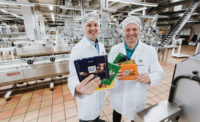How Syntegon helped Ritter Sport create paper packaging
The chocolate company’s new paper pouches are made on machines that gently handle paper, allow for flexibility, and offer stability at high speeds.

Ritter Sport chocolates are known for their iconic packaging, so creating a more sustainable version had to factor in both usability and brand images.
The German-based chocolate manufacturer decided to work with Syntegon Technology to make that goal a reality.
The packaging machinery specialist has helped Ritter Sport develop packaging solutions for its popular chocolate bars for more than four decades.
The latest successful project is paper pouches for the colorful Ritter Sport mini editions.
Ritter’s history of sustainability
Sustainability has been an integral part of Ritter Sport’s mission for years. In 1991, the company pledged to introduce sustainable processes along its entire production chain.
By 2018, Ritter Sport had become the first big manufacturer of chocolate bars to source only certified sustainable cocoa for its products, which is supplied by farmers and cooperatives in Nicaragua, Peru, Ghana, Nigeria and the Ivory Coast.
In parallel, the company started developing more eco-friendly packaging alternatives for its square chocolate tablets. Together with the experts of Syntegon, formerly Bosch Packaging Technology, Ritter Sport collaborated to try out new packaging alternatives for the Ritter Sport mini editions.
Development as a real partnership
“Our goal was to use a material out of renewable resources, which can be disposed via the paper recycling stream. This also meant that we needed to find a fitting packaging machine, which is not only able to gently handle paper, but also allows a flexibility for different packaging formats and runs stable at high speed,” said Ivo Buncuga, head of technical department at Ritter Sport.
Instead of the common paper trays overwrapped with plastic film, Ritter Sport opted for a more sustainable paper packaging alternative to improve the product’s ecological footprint. Besides its good recycling properties, paper also allows a variety of designs and has good haptic qualities, attracting customer attention at the point of sale.
When used for secondary packaging, paper needs to be handled much more carefully than plastic film. It is both stiffer and less robust, and might crease or tear during the packaging forming process or due to the product drop impact. Hence processing the material on high speed packaging machines requires a lot of expertise to achieve flawless packaging.
Syntegon and Ritter Sport analyzed the perfect interplay between operator, machine, product, and paper material.
“We explored a variety of packaging styles and paper materials before deciding which solution fits our product best,” Buncuga said. First paper tests were run on an SVE 2520 vertical bagger to see how the different paper materials behave on the machine. Technical and material requirements were then optimized to achieve a stable and reliable process with the chosen paper material.
A premium sustainable packaging solution

After reviewing the results of the testing phase, Ritter Sport decided in favor of a stand-up paper pouch for its different types of small, primary packaged chocolate bars such as the Ritter Sport minis or the Choco Cubes.
The premium paper pouch (pictured above) is an eco-friendlier packaging option and stands tall on the shelf as a real eye-catcher. The haptics of the fully recyclable packaging further supports customers’ positive first impression of the product.
For the sturdy, smooth and flex-crack-resistant paper pouches, the existing SVE 3220 vertical bagger from Syntegon was upgraded.
“Syntegon was the first company on the market to produce and process vertical paper bags, so their expertise was a huge asset for the project,” said Buncuga. “They proactively supported us along the whole process with valuable improvements and solved challenges throughout the journey – from the first test runs at their site in Weert to the final product launch in spring 2021.”
Providing flexibility

Flexibility was another important requirement in the project.
Since the Ritter Sport minis are not packaged in paper pouches for all markets right from the start, the solution needed to be easily adaptable to different packaging materials and styles. The SVE vertical bagger (pictured above) processes both paper and plastic film.
When choosing the new doy-style packaging, the machine produces up to 60 paper bags or 80 plastic bags per minute. Format and material changes can be performed quickly and easily, keeping downtime to a minimum.
The machine also allows Ritter Sport also to package pillow pouches in both materials with an output of up to 100 per minute, giving Ritter the utmost flexibility during production.
This new paper packaging solution is an important milestone in Ritter Sport’s sustainability efforts. However, the German chocolate manufacturer is far from slowing down.
“We have exciting projects in the pipeline. We are already working with Syntegon to find possibilities of using paper as a primary packaging for our original square chocolate tablets,” Buncuga says.
The challenges of wrapping chocolate in paper
In combination with a sensitive product such as chocolate, paper packaging poses its own challenges.
When used as primary packaging, it must provide sufficient barrier protection. The requirements vary according to the flavor profile and the ingredients.
Higher contents of nuts, nougat, creams or fruity fillings mean an increase in fat, which calls for higher barrier properties. The same is necessary if alcohol or different aromas are added to achieve a complex chocolate flavor. In these cases, the fully recyclable propylene is still the most sustainable packaging material.
Chocolate bars containing a high amount of cocoa, in turn, are better suited for primary paper packaging. Ritter Sport worked on a pilot project with Syntegon to develop a paper-based packaging solution for some of its products.
The main challenge for the development team was to find a way to make gusseting folding work with the wrapping material, so that the finished packaging is both robust and keeps the product’s typical ‘knick pack’ packaging functionality.
First test runs with 100-gram chocolate were performed on existing Syntegon machines from the Pack Series for horizontal flow-wrapping with the support of the competence center in Beringen.
The machines have been equipped with the new forming shoulder of the retrofit-kit “paper-ON-form”, which is especially designed for cold-sealed paper. It reduces the stress on the paper during forming since the forming unit and sealing jaws are pre-configured based on the desired pack size and the material characteristics.
Working on future-proof packaging

In autumn 2020, a small quantity of Ritter Sport’s chocolate tablets Schoko & Gras wrapped in paper (pictured above) were launched in a test market.
Step by step, Ritter Sport will switch further primary and secondary packaging to paper-based solutions.
Ritter Sport’s reliable partnership with Syntegon has come full circle: More than 45 years ago, the chocolate manufacturer invented its signature Knick-Pack format together with the Syntegon experts at the former Tevopharm site in Schiedam in the Netherlands.
“Today, we are still in close contact working together on new packaging solutions. This time focusing on sustainable versions of our packaging that still has the characteristic design,” Buncuga said.
Looking for a reprint of this article?
From high-res PDFs to custom plaques, order your copy today!






